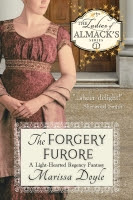I’ve been having fun reading Jane Austen-related or themed books over the last few months in celebration of the 200th anniversary of the publication of Pride and Prejudice. Some have been serious looks at aspects of Jane Austen’s world. Others have been lightweight “fun” books, while others have used Jane and her world as a way to look at our own, with varying degrees of humor (and, I might add, success.) Only one has completely captivated me.
The Real Jane Austen: A Life in Small Things by Paula Byrne (HarperCollins, 2013) is not quite a biography, not quite a history, not quite literary criticism, though it accomplishes all those things. It takes a slightly sideways approach to Jane Austen and her work: it uses physical items, many of them her personal or family belongings, to examine aspects of her life, the culture of late 18th and early 19th century England, and, of course, her works. Through a Kashmir shawl, Byrne examines Austen family history and connection to the wider world, laying to rest 19th century biographers, many of them Jane’s relatives, who tried to paint her as a secluded countrywoman with little knowledge of the outside world. Through a page in the church register in Jane’s father’s church, where a young Jane playfully scribbled in several marriages for herself, Jane’s love life and views on romance and sex are examined.
The book wanders delightfully from subject to subject; an advertisement from a newspaper announcing the auctioning of the Austen’s furniture upon Jane’s father’s retirement mentions, among the goods to be sold, several theatre scenes (painted backdrops), which launches an examination of the Austen family’s love of theatre and the role theatre plays in Jane’s books, particularly Mansfield Park. I have to confess that Mansfield Park was always my least favorite of her works, but in the middle of this chapter I found myself going back and rereading it and gaining a deeper appreciation of and liking for the story (though I still can’t view Edmund as hero material. Just ain’t gonna happen.)
The other thing this book accomplishes, as far as I’m concerned, is to demolish the rather mealy-mouthed picture of Jane painted by her early biographers, many of them her own close relatives. They tried to present a picture of her as a demure, home-loving Victorian spinster, which simply wasn’t the case: Jane Austen loved to travel and jaunt about London when she had the chance, could have an earthy sense of humor at times, and was, overall, much more a product of the more open-minded 18th century than of the more prudish 19th.
So if you want to read one Jane Austen-related book this year, I highly recommend The Real Jane Austen. It’s not a light and fluffy read, but it’s always an interesting one.
Subscribe to:
Post Comments (Atom)






4 comments:
Sounds like an interesting read, and I love that it's grounded in physical evidence.
It was a very interesting read. I hope that if anyone picks it up, they'll come back and comment here.
I'll keep an eye out for that book, Marissa! Good to know it's worth the reading...
Cara
I just finished the book last night and I found it really interesting. I liked the different approach to the story of Jane Austen's life and times. Some of the author's comments were a bit controversial and she can't tell the difference between Charlotte and Emily Bronte but overall I enjoyed it. I'm off to write a full review now.
Post a Comment